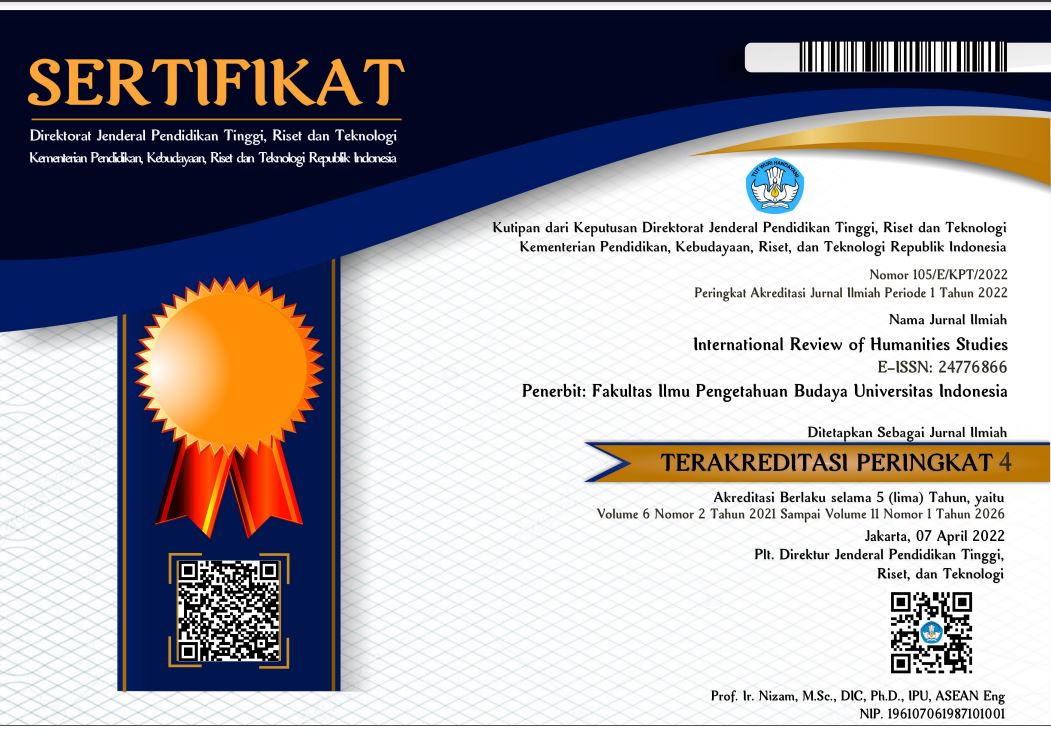International Review of Humanities Studies

Abstract
This paper discusses the journey of Pasar Baru Post Office using The Biography of Things study in which observes the building from time to time. Pasar Baru Post Office is used as the main source in this paper. Amidst the changes since The Netherland-Colonial era, the building remains still and that became the reason this study was conducted through The Biography of Things study. The research method used in this article is the research framework of Sharer and Ashmore which consists of data collection, processing, and interpretation. The results of the study show that there are some changes in the physical form of the building or its commodification, which can be included as a way to put off the past colonial memory. This can be seen throughout the values and functions shifting that were once used as a place for postal and philatelic services, now the building has become a public creative space.
References
1980. Sejarah Pos dan Telekomunikasi di Indonesia: Jilid I Masa Pra Republik. Jakarta: Jakarta: Direktorat Jenderal Pos dan Telekomunikasi.
1980. Sejarah Pos dan Telekomunikasi di Indonesia: Jilid II Masa Kemerdekaan Indonesia. Jakarta: Direktorat Jenderal Pos dan Telekomunikasi. Abrianto, O & Hermawan, I.
2020. Pola Tata Ruang Weltevreden dan Fungsi Ruang Kota. Jurnal Panalungtik, 3(1): 1—13. Akihary, H. 1988. Architektuur & Stedebouw In Indonesie 1870—1970. De Walbug Pers. ANRI.
2018. Inventraris Arsip Pos-, Telegraaf- en Telefondienst 1817—1950. Direktoral Pengolahan Arsip Nasional Republik Indonesia. Arsip Dinas Kebudayaan DKI. Gedung Filateli Pos Bloc Jakarta.
Ashmore, W., & Sharer, R. J. 2003. Archaeology: Discovering the Past.
Cloke, P., & Perkins, H. C. 2002. Commodification and adventure in New Zealand tourism. Current issues in tourism, 5(6), 521-549.
Connerton, P. 2017. Seven types of forgetting. In The Present Word Culture, Society and the Site of Literature 150-165.
Drieënhuizen, C. 2014. Objects, nostalgia and the Dutch colonial elite in times of transition, ca. 1900–1970. Journal of the Humanities and Social Sciences of Southeast Asia, 170(4), 504-529.
Featherstone, M. 2007. Consumer Culture and Postmodernism: Lifestyle and Consumer Culture.
Gosden, C & Marshall, Y. 1999. The Cultural Biography Of Objects. World Archaeology, 31(2): 169—178.
Handinoto, H. (2009). Daendels Dan Perkembangan Arsitektur Di Hindia Belanda Abad 19. DIMENSI (Journal of Architecture and Built Environment), 36(1), 43—53.
Hodder, I. 1985. Postprocessual archaeology. Advances in archaeological method and theory. 8: 1-26.
Ihsan, N. 2019. Dari Artefak ke Biografi Ruang: Respektif Biografis dalam Membaca Perkembangan Lanskap Kota. Jurnal Tumotowa, 2(2): 72—81.
Joy, Jody. 2009. Reivigorating Object Biography: Reproducing The Drama Of Object Lives. World Archaeology, 41(4): 540—556.
Juwono, S. 2002. Kajian Morfologi Kawasan Kantor Pos Bersejarah. Disertasi:Universitas Diponegoro.
Kopytoff, I. (1986). The cultural biography of things: commoditization as process. The social life of things: Commodities in cultural perspective, 68, 70-73.
Longhurst, Brian. 2008. Introducing cultural studies. Second edition. London: Routledge
Marwoto, Irmawati. 2019. From Rubbish to Cultural Identity. Wacana. 20(2): 317—351
Recommended Citation
Varidy, Vherendio Novtha and Marwoto, Irmawati
(2024)
"A STUDY ON BIOGRAPHY OF THINGS: POSBLOC PUBLIC CREATIVE SPACES,"
International Review of Humanities Studies: Vol. 9:
No.
1, Article 14.
DOI: 10.7454/irhs.v9i1.1281
Available at:
https://scholarhub.ui.ac.id/irhs/vol9/iss1/14
Included in
Anthropology Commons, Art and Design Commons, Creative Writing Commons, Cultural Heritage Law Commons, Education Law Commons, Film and Media Studies Commons, History Commons, Intellectual Property Law Commons, International and Area Studies Commons, Legal Writing and Research Commons, Linguistics Commons, Museum Studies Commons, Philosophy Commons, Urban Studies and Planning Commons


